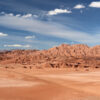Researchers have found that the movement of glaciers in Greenland is more complex than previously thought, with deformation in regions of warmer ice containing small amounts of water that account for motion that had often been assumed to be caused by sliding where the ice meets the bedrock beneath.
The international team of researchers led by the University of Cambridge used computer modeling techniques based on earlier fiber-optic measurements from the Greenland Ice Sheet to build a more detailed picture of the behavior of the world’s second-largest ice sheet.
Their results, reported in the journal Science Advances, could be used to develop more accurate predictions of how the Greenland Ice Sheet will continue to move in response to climate change.
Mass loss from the Greenland Ice Sheet has increased sixfold since the 1980s and is now the single largest contributor to global sea-level rise. Around half of this mass loss is from surface meltwater runoff, while the other half is driven by discharge of ice directly into the ocean by fast-flowing glaciers that reach the sea.
The RESPONDER project is exploring the dynamics of the Greenland Ice Sheet using a combination of physical measurements and computer modeling.
The current research builds on earlier observations reported by the RESPONDER team in 2021 using fiber-optic cables. In that work, the team found that the temperature of ice sheets does not vary as a smooth gradient, but is far more heterogeneous, with areas of highly localized deformation warming the ice further.
The borehole measurements also showed that the ice at the base contains small amounts—up to roughly two percent—of water. In some parts of the ice sheet, this mixed ice-water layer, called temperate ice, was around eight meters thick, but in other parts it was up to 70 meters thick.
“The addition of even tiny amounts of water softens the ice considerably, transforming it into a unique material with substantially altered mechanical characteristics,” said first author Dr. Robert Law, who completed the work while based at Cambridge’s Scott Polar Research Institute and is now based at the University of Bergen. “We wanted to know why the thickness of this layer varied so much, because if we don’t fully understand it, our models of ice sheet behavior won’t fully capture the physical processes occurring in nature.”
“The textbook view of glacier motion is that it occurs with a neat partitioning of basal sliding and internal deformation, and that both are well understood,” said co-author and RESPONDER project leader Professor Poul Christoffersen, who is based at SPRI. “But that’s not what we observed when we looked carefully in boreholes with new techniques. With less detailed observations in the past, it was difficult to get a really good picture of how the ice sheet moves and even more challenging to replicate it with computer models.”
Law, Christoffersen and their colleagues from the U.K., U.S., Switzerland and France developed a model based on their earlier borehole measurements that can account for all of the new observations.
Importantly, they accounted for natural variations in the landscape at the base of the ice, which, in Greenland, is full of rocky hills, basins and deep fjords. The researchers found that as a glacier moves over a large obstacle or hill, there is a deformation and heating effect which sometimes extends several hundred meters from the ice sheet base. Previously, this effect was omitted in models.
“The stress on the ice base is highest at the tops of these hills, which leads to more basal sliding,” said Law. “But so far most models have not accounted for all of these variations in the landscape.”
By incorporating these variations, the model developed by the researchers showed that a variable layer of temperate ice forms as the glacier moves over the landscape, whether the glacier itself is fast- or slow-moving. The thickness of this temperate ice layer agrees with the earlier borehole measurements, but diverges significantly from standard modeling methods used to predict sea level rise from ice sheets.
“Because of this hilly landscape, the ice can go from sliding across its base almost entirely to hardly sliding at all, over short distances of just a few kilometers,” said Law. “This directly influences the thermal structure—if you’ve got less basal sliding then you’ve got more internal deformation and heating, which can lead to the layer of temperate ice getting thicker, altering the mechanical properties of the ice over a broad area. This temperate basal ice layer can actually act like a deformation bridge between hills, facilitating the fast motion of the much colder ice directly above it.”
The researchers hope to use this improved understanding to build more accurate descriptions of ice motion for the ice sheet models used in predicting future sea level rise.
More information:
Robert Law et al, Complex motion of Greenland ice sheet outlet glaciers with basal temperate ice, Science Advances (2023). DOI: 10.1126/sciadv.eabq5180
Provided by
University of Cambridge
Citation:
Researchers build more detailed picture of the movement of the Greenland Ice Sheet (2023, February 10)



